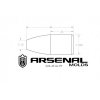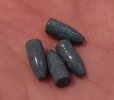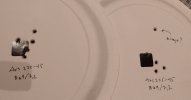Spindrift
Well-Known Member
This is my first slick- sided mould. I’ve had it for a few months, but have only cast and shot a little with it yet- the mould is barely broken in. But time has come to find out what this little bullet can do, and I’ll post my experiences (for better or worse) in this thread.
First, a few notes and thoughts regarding the design. The bullets in the photo below are not sized yet.


As you can see from the technical drawing, a slick- sided, bevel- based bullet. I asked for a mould dropping .224 bullets. I wanted the option of sizing .225 or .226 after coating. If the bullet is quite over- sized in the first place, you might extrude a skirt at the base when sizing down. .224 works fine.
I wouldn’t have minded a slightly larger meplat and a more gently tapering nose. But I decided to get this mould, and see what I could get out of it.
To allow myself some speculation first, what are the pro’s and con’s of a slick- sided, bevel- based bullet?
Pros:
- the lack of grooves makes the bullets drop very easily from the mould
- there are very few sharp angles to fill out. You simply can’t make rounded driving bands on this one. Easier to make bullets in near- perfect static balance?
- the slick sides are extremely revealing to even minor imperfections that might otherwise escape your notice when culling
- the bevelled base provide a sort of refuge for metal, displaced during sizing or engraving
Cons:
- the lack of (displacement) grooves should increase stress on the base during engraving, and might increase risk of riveting in the throat/ barrel transition
- the bevelled base makes identification of bad bases more difficult (the trick is to identify the bad ones after cutting the sprue, before releasing the bullets from the mould)
- by choosing a slick, you loose the option of using conventional lubing techniques.
I hoped for a mould that would be very productive, with low cull rate, producing easily sorted/ inspected bullets that yet shot reasonably well with moderate loads- without decimating my alloy stash too much.
So far, I’ve shot a few groups with my CZ527 in .222 rem. This rifle has a slightly shortened barrel threaded for a suppressor, and is currently equipped with a 3-9x40 mil-dot scope.
I started quite low, and got some uninspirational 1,5-2 MOA groups. Yesterday, I decided to increase the load intensity a bit, to see what would happen.
The powder is the French Vectan Ba9, a short-grained single base extruded powder with listed burning speed similar to Unique. It meters beautifully. If you listen closely while shooting, it goes «bangue» on behalf of its French origin.
At 6,9 grs, I got about 1,5 MOA 5-shot groups. At 7,2grs (the hottest I’ve tried so far), the two groups tightened up nicely. I got one flier, as I (unwisely) tried to shoot through a bit of mirage (builds quickly with suppressed gun in cold weather). Looks like the bullet prefers to be pushed a little, and 1 MOA at 100m is quite achievable. Now, I have a rough idea of the preferances of this bullet. I also look forward to testing these in my .223.
Now, it’s time to fire up the pot and cast some more! Casting small .22 bullets in the winter cold can be a bit challenging.

First, a few notes and thoughts regarding the design. The bullets in the photo below are not sized yet.


As you can see from the technical drawing, a slick- sided, bevel- based bullet. I asked for a mould dropping .224 bullets. I wanted the option of sizing .225 or .226 after coating. If the bullet is quite over- sized in the first place, you might extrude a skirt at the base when sizing down. .224 works fine.
I wouldn’t have minded a slightly larger meplat and a more gently tapering nose. But I decided to get this mould, and see what I could get out of it.
To allow myself some speculation first, what are the pro’s and con’s of a slick- sided, bevel- based bullet?
Pros:
- the lack of grooves makes the bullets drop very easily from the mould
- there are very few sharp angles to fill out. You simply can’t make rounded driving bands on this one. Easier to make bullets in near- perfect static balance?
- the slick sides are extremely revealing to even minor imperfections that might otherwise escape your notice when culling
- the bevelled base provide a sort of refuge for metal, displaced during sizing or engraving
Cons:
- the lack of (displacement) grooves should increase stress on the base during engraving, and might increase risk of riveting in the throat/ barrel transition
- the bevelled base makes identification of bad bases more difficult (the trick is to identify the bad ones after cutting the sprue, before releasing the bullets from the mould)
- by choosing a slick, you loose the option of using conventional lubing techniques.
I hoped for a mould that would be very productive, with low cull rate, producing easily sorted/ inspected bullets that yet shot reasonably well with moderate loads- without decimating my alloy stash too much.
So far, I’ve shot a few groups with my CZ527 in .222 rem. This rifle has a slightly shortened barrel threaded for a suppressor, and is currently equipped with a 3-9x40 mil-dot scope.
I started quite low, and got some uninspirational 1,5-2 MOA groups. Yesterday, I decided to increase the load intensity a bit, to see what would happen.
The powder is the French Vectan Ba9, a short-grained single base extruded powder with listed burning speed similar to Unique. It meters beautifully. If you listen closely while shooting, it goes «bangue» on behalf of its French origin.
At 6,9 grs, I got about 1,5 MOA 5-shot groups. At 7,2grs (the hottest I’ve tried so far), the two groups tightened up nicely. I got one flier, as I (unwisely) tried to shoot through a bit of mirage (builds quickly with suppressed gun in cold weather). Looks like the bullet prefers to be pushed a little, and 1 MOA at 100m is quite achievable. Now, I have a rough idea of the preferances of this bullet. I also look forward to testing these in my .223.
Now, it’s time to fire up the pot and cast some more! Casting small .22 bullets in the winter cold can be a bit challenging.


